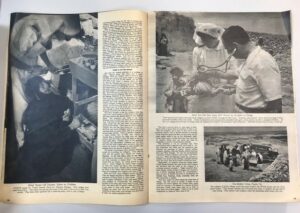Beatriz Da Cunha Gomes: the ethics of journalism
Creative Writing and Journalism student Beatriz Da Cunha Gomes ponders the ethics of journalism and informed consent, inspired by copies of Picture Post
How far has journalism actually come?
Journalism has been around since we’ve been able to write, maybe even earlier. The earliest known journalistic piece dates to 59 BCE in ancient Rome. A news sheet which logged important daily events called the Acta Diurna. The need to share news is a very human phenomenon. As we evolve as a race and develop new concepts of morality and beliefs, journalism has evolved too. However, I consider it hasn’t evolved as much as we’d like to believe.
When reading Picture Post from 1949 to 1950, it got me thinking about the ethics of journalism and how much we have actually evolved. In terms of the big picture, journalism seems to have stopped elevating colonialism and minimising people of colour and their struggles as well as being more mindful of language and correct terminologies.

Looking at Picture Post from 1949, there are several articles about underprivileged people and how they live. The text has an undertone of pitifulness while frowning upon their lifestyles. Furthermore, a particular article struck me. It was about the rebuilding of Tito, the carefree narration of these people’s suffering, as if it were a fictional story. This raises the question; were the people being interviewed and photographed given consent forms? Were they aware what would happen to their pictures and statements?
“informed consent”?
Consent forms as a concept was first legally discussed in 1905, in the medical field, with the cases of Mohr v Williams and Pratt v Davis. However, the principle of “informed consent” stayed not legally binding until 1957, when the term was publicly recorded in the case Salgo v Leland Stanford Jr University Board of Trustees. With this in mind, it is only practical to assume journalists at the time would not inform its subjects of their motives and the articles’ outcomes.
As much as we would like to argue how much we have improved since then, when it comes to tragedies and major events, it seems that morality and consent go out the window. Socially, we claim photographing catastrophes, such as the Holocaust, to be acceptable since they serve as reminders of how cruel humans have been in the past and could be in the future. But how thin is the line between remembering and traumatizing? Isn’t there something to be said about the profiting off and constant trauma reminder these photographs foist upon the minorities involved? Are there rules that separate the morally correct from the incorrect in news reporting or is everything fair game? Thinking about all this, journalism hasn’t evolved much since Picture Post was being published, using images and reports from people who most likely did not consent to it.
I can appreciate how much we have evolved in terms of news reporting and protecting people’s integrity and privacy. However, there is still a long way to go. From exploiting people in dangerous or tough situations to report a story to photographing them as visual clickbait to impact the readers. Where is our humanity and compassion?